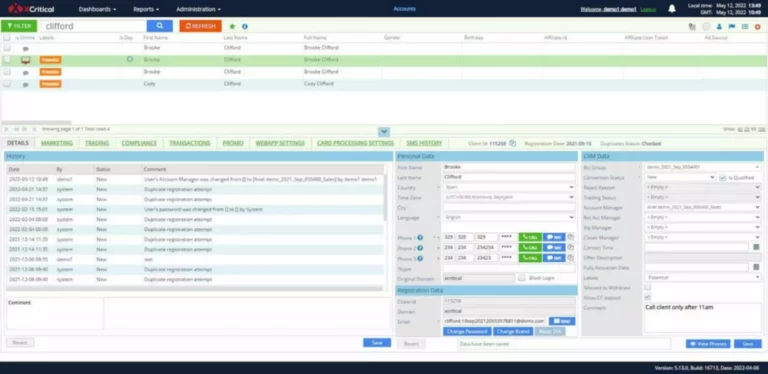Content
First, if a bank declines to grant loan until the old loan is repaid, the disheartened liquidity soft solutions forex borrower will have to minimize production which will ultimately affect business activity. If all the banks pursue the same rule, this may result in reduction in the money supply and cost in the community. As a result, it makes it impossible for existing debtors to repay their loans in time. The central bank was expected to increase or erase bank reserves by rediscounting approved loans.
- In certain geographic regions there are certain mandatory central bank reporting to be done.
- It gives a clear indication of financial health, and it provides visibility into how well a company can afford its current and future debts, short-term investments, obligations, and spent with its liquid cash and assets at hand.
- This minimizes the amount of inventory on hand by only ordering what is needed to meet customer demand.
- Unexpected costs from medical bills and home repairs can also quickly create liquidity crunches if proper precautions are not taken.
Accounting Jobs of the Future: How Staffing Agencies Can Help Land Them
Good asset liability management broadly covers portfolio accounting, analytics and optimization. It relies on a suite of tools for transaction capture, forecasting, interest rate risk measurement, stress testing, liquidity modeling and behavioral analytics. Let’s take https://www.xcritical.com/ an example of company XYZ and take a look at their monthly cash flow statement.
Reading Financial Statements for Liquidity Insights
Liquidity, like profitability and solvency, is calculated as a financial ratio, which is used to understand business development. Liquidity shows how well a company can meet its short-term debt obligations and therefore how flexible it is financially. Sound liquidity management can also place organizations in a far better position to capitalize on business opportunities, increase turnover, and Mining pool maintain a competitive edge. While vital, maintaining excessive liquidity can also limit profitability and growth. Companies must strike a delicate balance between ensuring adequate liquid reserves and making strategic investments in innovation or expansion.
Role of Banks and Financial Institutions in Liquidity Management
Here we show you why it is so important for companies, how it works in principle and how companies can implement it in practice. One key decision here is to determine who to interface with internally and externally. Let’s take a closer look at the sources of the liquidity inputs, both internal and external, to help you make that decision. Liquidity management is the strategy an organization employs to refine, expand and secure its liquidity. When shopping for a liquidity management tool, executives need to pay close attention to its reporting automation features.
This ensures that they have enough liquid assets to meet short-term obligations while also optimizing the use of available funds. Efficient handling of cash and liquidity enables firms to prevent bankruptcy, lower borrowing costs, and capitalize on investment opportunities. Good liquidity management helps ensures the availability of funds to meet all cash outflow commitments for day-to-day operations and deploys cash in an optimal manner.

Be it through proactive budgeting, efficient invoicing, or effective collections management, managing liquidity will help keep your cash flow positive and avoid costly disruptions to your operations. Liquidity management is the proactive process of ensuring a company has the cash on hand to meet its financial obligations as they come due. It is a critical component of financial performance as it directly impacts a company’s working capital.
Managing accounts payable involves negotiating favorable payment terms with suppliers and making timely payments to maintain positive vendor relationships and take advantage of early payment discounts when available. Liquidity risk relates to short-term cash flow issues, while solvency risk means the company is insolvent on its overall balance sheet, especially related to long-term debts. The primary challenge is accurately anticipating all incoming (customer payments, asset sales, VAT refunds) and outgoing (supplier payments, salaries, taxes, loan repayments) cash flows over a 12- to 18-month horizon. After the potential sources or uses of liquidity are identified, the user can create a liquidity structure as per available documentation. A liquidity structure is an arrangement of different accounts in which fund movement takes place. The structure can have multiple levels and can span across various countries, banks, currencies and entities.
This theory also states that whenever commercial banks make short term self-liquidating productive loans, the central bank should lend to the banks on the security of such short-term loans. This principle assures that the appropriate degree of liquidity for each bank and appropriate money supply for the whole economy. The commercial loan or the real bills doctrine theory states that a commercial bank should forward only short-term self-liquidating productive loans to business organizations. Loans meant to finance the production, and evolution of goods through the successive phases of production, storage, transportation, and distribution are considered as self-liquidating loans. Additionally, a company may use a procurement tool to gain visibility and control over inventory, budgets, expenses, invoices, and orders. For example, Precoro lets stakeholders get the information needed to build the forecast, as each expenditure is documented in the system.

Financial institutions can then recover pledged collateral if the company defaults on loans. We’ll define key terminology, analyze financial statements, explore liquidity planning tactics, review illuminating case studies, and recap why skillful liquidity management is the lifeblood of organizational success. You can already see that for detailed cash flow planning, data from many different sources are necessary and a lot of data has to be collected. If you also create an overview of past cash flows, you can also see what the company regularly spends money on (e.g. recurring expenses such as salary payments and general operating costs). This enables effective cost control and gives a deeper insight into the company’s cash situation. This is achieved by diversifying funding sources, stress-testing your liquidity positions, establishing contingency funding plans, and keeping a close eye on your liquidity at all times.
It gives a clear indication of financial health, and it provides visibility into how well a company can afford its current and future debts, short-term investments, obligations, and spent with its liquid cash and assets at hand. Optimal liquidity management enables complete visibility into financial resources, spent, cash, and liabilities at any point in time. For finance teams, cash flow is still the most important aspect of liquidity management.

Establishing lines of credit with financial institutions can provide companies with a flexible source of funds to address temporary liquidity shortfalls or finance growth opportunities. To manage the situation, Acme Corp. considers selling some of its long-term investments. However, the market conditions remain unfavorable, and the returns on selling these investments at this juncture would incur a significant loss. The company also explores laying off some of its workforce to reduce operational costs, but this comes with the risk of losing skilled labor and facing potential legal and reputational repercussions. The dynamic nature of corporate operations, coupled with the absence of regulatory frameworks akin to those enveloping banks, calls for a tailored approach towards managing liquidity risk.
Cash visibility provides insights into whether there is a cash surplus or deficit, allowing stakeholders to make decisions promptly. Proper cash management ensures that the organization can meet its short-term obligations, avoiding insolvency and financial distress. So another feature of excellent liquidity management is a treasurer’s ability to develop strategies where there is sufficient cash available for investments, while ensuring the solvency of the company. These include cash flow shortages that could result in defaulting on loans, troubled relationships with vendors, a lower credit rating, and even bankruptcy. The majority of companies use Excel for liquidity management, whereby the account transactions are manually entered into a table.
By leveraging such instruments astutely as part of a broader liquidity management strategy, treasurers can significantly bolster their corporation’s liquidity safety net. By constructing a liquidity portfolio across cash, cash equivalents and liquid marketable securities, companies can strike an optimal balance between liquidity and yield based on their risk tolerance. Companies aim to strike an optimal balance – holding enough liquidity to operate smoothly while minimizing unproductive assets. The key differences between them can provide advantages to business cash management plans.
As a result, the firm may miss the payment deadline, miss early payment or bulk discounts, and make untimely investments. A company suffers from insufficient cash reserves when it fails to maintain enough liquid assets to cover unexpected expenses, such as equipment repairs or regulatory fines. This risk can arise from poor financial planning, high operational expenses, or missed sales targets. Effective liquidity management helps a company avoid financial distress and optimizes its use of capital. Strategic liquidity management enables a company to be prepared for unexpected expenses and opportunities, ensuring operational stability.